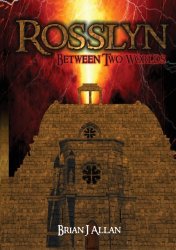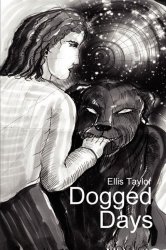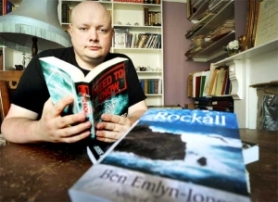 Rosslyn~ Between Two Worlds
Rosslyn~ Between Two Worlds
by Brian Allan
Brian’s website: http://brianjallan-home.co.uk/
Ben Fairhall is a writer, a researcher and a theologian.
It is another of the strange coincidences surrounding the death of Dean Warwick at last month’s PROBE conference (see Fear and Loathing in St. Annes) that on the night it happened, France should be playing Scotland at football. (The Scots won.) France and Scotland: the two countries perhaps most intimately connected with the Templar mythos, and its Merovingian cousin. Another cosmic hint perhaps? The following day Brian Allan gave a well-received presentation of the latest developments in his ongoing researches into the anomolies and mysteries of Rosslyn, the Scottish chapel that plays such an important part in the those mythologies. What he has discovered, whilst not entirely novel, will be of great interest to those growing numbers of people connecting with this ancient place of worship; and the sense of its importance in the years running up to 2012.
The main thrust of his research- that the cubed ornamentation of Rosslyn’s Lady Chapel contain ‘some sort of mysterious musical code’- is not new. One notable proponent of the idea, who Brian Allan is quick to credit, is the late Steven Prior; who purported to have been the head of parapsychology for Britain’s MI5. In developing this idea, Allan has made a thorough study of the wave patterns carved into the cubes, and has likened them- sensibly, in my opinion- to the acoustic waves first produced by Ernst Chladni in the eighteenth century. These were achieved using fine sand, metal plates and a strung bow drawn across the plate to create the desired frequency, which would be converted into visual form in the sand.
Such ideas are very timely: as the interest in the work of Dr Masuru Emoto with water crystals has shown (as featured in the movie What The Bleep Do We Know?) Crop circle researchers are developing similar theories to explain the glyphs that have been appearing in fields since the late 1980s. And in 1967, Hans Jenny published his book Cymatics: The Structure and Dynamics of Waves and Vibrations- featured in a recent issue of NEXUS magazine- which gave further evidence of this vital link between sound and physical matter. Using vibrating metal plates powered by crystal oscillators, he was able to demonstrate that the visual forms created by the sound of ancient Hebrew and Sanskrit vowels matched the written form of those letters; confirmation that these ancient languages are truly magical, with the ability to significantly affect the environment. Significantly, though not surprisingly for people researching the deterioration of humanity’s higher functions, this correspondence did not occur when he substituted modern English vowels.
Brian Allan observed a similarity between many of the patterns on the cubes and the wave formations discovered by Chladni. Through further research, and a series of coincidental meetings with helpful people, Allan was directed to the ‘Devil’s Chord’ as the most likely candidate for the musical interval encoded in this way. This is the augmented fourth, which was prohibited by the Church in the twelfth century (but which turned up in Jimi Hendrix’s Hey Joe and O Fortuna from Carmina Burana in more recent years.) Using a laptop and enlisting the assistance of an acoustic healer, Allan recreates the frequency in the Chapel. The effects are fairly dramatic: playing the two tones that comprise the augmented fourth produces another two separate notes, as though the effect was a design feature of the stonework. The same principal underlies the devices produced by the Munro Institute, for example, which apply two notes of slightly differing frequencies to the left and right ear. The brain responds to the stimulation by producing a third tone- the binaural- which, in terms of frequency, is the difference between the two. Interestingly, this technology has been widely used to trigger deep meditative states (in the Alpha and Delta frequency range) and out-of-body experiences; and Allan is quick to wonder whether the Chapel, under the right acoustic conditions, could have performed a similar function.
Of key importance to his investigation was the effect the tones would have on the dimensional doorway he and a team of psychics had already discovered. Here, of course, the sceptic- assuming he has made it this far- rapidly disembarks. It is a cold fact of life that, presented with photographs of any unidentified portal- whether those photos be taken in Rosslyn or the local Happy Eater- your average crystal ball gazer will probably declare it to be a stargate. In fairness to Mr Allan, however, the quality of mediumship displayed by his assistants is generally of a high order, particularly when Patrick McNamara is invited to offer a psychometric response to photographs taken in the Chapel. Without knowledge of either the place or its associated mythos, McNamara reels off a long series of symbolic (and specific) correspondences whose effect is rather creepy.
The dimensional doorway, whatever its exact purpose, appears to react to the pulsating frequencies- almost as if it is able to extract energy from them. What is rather conspicuous is that Allan’s rather cheerful disposition towards the (alleged) presence of this portal is not shared by the majority of his correspondents, whose e-mails upon the subject he reprints. In a brief history of some of the weirder aspects of Rosslyn’s history, he mentions the keen interest in it shown by Rudolf Hess. McNamara- in trance- reveals that the doorway can be opened to empower individuals with ‘the power of fury, allowing terrible spirits of great force who would add courage or great viciousness to an individual… this gives you power of arms that you would never have learnt before and making you become a fighting machine of great power and horror.’ According to Allan, the ‘key’ to opening the doorway may be the ‘Devil’s Chord’ or another series of intervals, or possibly a physical artefact secreted deep beneath the Crypt. (That this area is served by an intricate series of tunnels, connecting with other important buildings, is reasonably well-supported.) Whether the portal is meant to be opened, however- or whether it already has been- is ambiguous.
Combining several of the layers of the Rosslyn mythos into a satisfying whole, Allan concludes that the treasure lurking behind the Doorway, once activated by the requisite ‘key’, is none other than the Baphomet of the Templars. This mysterious head has arcane associations with the Apprentice Pillar- which sonic scans have revealed to contain an unknown object- the head of John the Baptist, and the Holy Grail itself. (In the proto-Grail romances of medieval Wales, the Mabinogion, the head of Bran the Blessed performs many of the functions later associated with the Grail.) In arriving at this satisfying conclusion, he draws upon the definition of Eliphas Levi (whose image of Baphomet has attained iconic status) who derived the name from reversing the Latin abbreviations ‘Temp Ohp Ab’ to reveal (translated) ‘The father of universal peace among men.’ Another source of the name may be from the Arabic ‘Abu-fihamat’, meaning ‘father of understanding.’ Both contain the idea of knowledge, or gnosis; and it is knowledge (the real Baphomet) which Allan believes to be concealed in the Rosslyn doorway.
In another neat piece of occult conflation, Allan equates this knowledge- the Baphomet- with H P Blavatsky’s notion of the Akashic records; and can extend further, to what scientists have termed our ‘junk DNA.’ As I revealed in an earlier post, the ‘junk DNA’ contains what transpersonal analysts call the ‘collective unconscious’ which- when activated to a higher degree- results in the visitations and witness reports associated with UFO and paranormal phenomena; and in the mystical states of consciousness associated with enlightenment and the (snake-like) kundalini. The secret of Rosslyn’s dimensional doorway, then, is spiritual knowledge which- when correctly applied- will result in the activation of all the dormant faculties of man, resulting in a brilliant influx of memory and capacity. All that is presently hidden within the subconscious- personal and collective- will truly rise again: to consciousness, from the darkness of the grave into the light of day. (The rituals of the Blue Degrees of Freemasonry are, in part, ritual enactments of this principle.) The Apprentice Pillar, then- though though generally believed to refer to the Sinclair ‘Prince’ who designed the Chapel- is the Tree of Life, the mechanism whereby this science can be accomplished; and the serpent DNA, whose activation awaits the correct recognition of the Divine Keys.
The idea of a cube containing the key to an interdimensional portal does, of course, bring to mind the British horror film Hellraiser. The cube, in this instance, is an antique puzzle box which- when the puzzle is correctly solved- acts as a gateway to and from an alternate dimension peopled by the Cenobites. This ‘Game Cube’ is known as the Lament Configuration, which would certainly hint at a connection with musical frequency- though this theme is not developed in the movie or its sequels (to the best of my knowledge.) Of great interest, however, is the fact that the Lament Configuration clearly depicts a Chladni figure on one of its sides; and bears a close resemblance to a typical Rosslyn cube. Just to throw in a little extra weirdness, both the original Hellraiser and Hellraiser III: Hell on Earth were released on September 11th (1987 and 1992 respectively.) And the fourth movie in the series is subtitled Bloodline.
The behaviour of the Cenobites in the Hellraiser series closely resembles that which is ascribed to the reptilians in the Emerald Tablets of Thoth, as translated by Maurice Doreal. They exist largely in a parallel dimension to our own, but under the correct circumstances they are able to shift into our reality in order to fuel up on the human blood that they appear to require for energy. Might this be an example of a writer, Clive Barker, through his heightened powers of imagination, activating a greater portion of the dormant ‘junk DNA’ and thus, in vision, accessing true occult knowledge from the Akashic records?
The reptilians, at any rate, do merit a brief mention by Brian Allan, in connection with the legendary line of Frankish kings known as the Merovingians. It will be recalled that the mother of their founder Merovee (or Meroveus) was believed to have been raped by the Quinotaur: a mythical sea-bull. Readers of my article, The Horsham Key will know that a similar creature can be found on Horsham’s Old Town Hall; though, in that instance, in a double-tailed form which recalls the melusine. To Melusine, in her non-fictional incarnation as Melisande, the mother of Fulk V, Count of Anjou and daughter of Baldwin II, is attributed uniting the Merovingian house with the line of Anjou; and thus to the Plantagenets who would produce several English monarchs. Both stories share an identical theme: of legendary sea-creatures giving rise to powerful bloodlines.
Such ideas have obvious similarities with the reptilian conspiracy thesis propagated by David Icke, Matthew Delooze and others; the major difference being that neither the Quinotaur or Melusine are described as extra-terrestrial. Allan suggests that the story (of Merovee’s legendary parentage) might point towards the existence of ‘an entirely new evolutionary stream of reptile/humans crossbreeds’; who, presumably- through the Merovingian line of descent- have a vital interest in Rosslyn. He fails to develop this theme much further, however; and thereby misses an extraordinary clue provided by the medium Patrick McNamara. Along with the other associations he produces via clairvoyance, is the name ‘Rose Egremont (or Egromont.’) Allan recognises that this may contain an important key to the mystery, and wonders about a possible connection to the famed ‘Rose Line’, the north-south meridian that connects Rosslyn with Glastonbury. A alternative explanation, however, may be found in the name of the mother of the princess raped by the Quinotaur: viz. Rosamund. It is from Rosamund- the grandmother of Meroveus- that De Rougement derives, the matriarch of the Hapsburgs: who, as stated, share a joint mythology that connects to the Merovingians. ‘Egremont’ and ‘De Rougement’ are sufficiently close to suggest that it is in this complicated web of family alliances that the solution to this clairvoyant enigma may reside.
We should also note that a yet earlier rendition of the Quinotaur/Melusine legend is the ancient Phoenician tale of Europa and the bull. Here again, a sea-bull ravages a maiden of high birth: Europa being the daughter of Canaan, the son of Poseidon. The Canaanite tribes included the Kenites, who descended from Cain: the son of Adam or- in certain rabbinical lore- Samael, following Eve’s act of union with the snake in the garden of Eden. Thus, in a convoluted manner, another association can be drawn between a serpentine, reptilian/amphibious beast and a bloodline of vital importance to the Grail mythos. (The Merovingian kings- and their descendants- are closely associated with the mythology of Cain.)
Might there be an implied kinship between the Cenobites and the Canaanite-Kenites, despite the dissimilarity in pronounciation, and the more obvious monastic association? Interestingly, in Hellbound: Hellraiser II (1988) the Cenobites worship a giant, rotating obelisk they call ‘Leviathan.’ This, Allan says, was one of the names given to the Baphomet figure used by Anton LaVey’s Church of Satan, and relates to one of the Lords of Hell. He fails to mention that Leviathan, like the Quinotaur and the fairy Melusine, is an aquatic beast; and that its usage by LaVey (and, by extension, Clive Barker in the Hellraiser films) may also relate to its potency as a well known symbol of the New World Order that the Church of Satan- in common with many ‘black’ occult groups- are working to inaugurate. This has been the case since the publication of the book of the same name by the influential political scientist Thomas Hobbes in 1651, in which he delineates his philosophy of absolute monarchism. The famous frontispiece is a symbolic illustration of this theme:
We should also note that the goddess (or princess) Europa is the source of the name of continental Europe; and that the image of Europa and the bull- which corresponds esoterically to the Quinotaur and his quarry- is widely used on EU documents, and Euro coinage. Once we understand that the same symbol can be applied to the Merovingians, and- through Melusine- to the Angevin line and the House of Lorraine (Hapsburgs)- the conspiracy thickens to monumental proportions. All of these groups have been associated with agitating for a fully centralised, federal Europe; which should give you some sort of indication what the medium-term agenda of the European Parliament is.
A final thought with regard to the cubes. In the Revelation of St. John we read prophecies related to the descent of the New Jerusalem: a symbol of spiritual regeneration. According to biblical exegetes, the shape of the perfected city seen in vision is a cube. (Others say a pyramid; one thinks of the ‘Perfected Ashlar’ of Freemasonry.) This would have had tremendous significance for William Sinclair, the architect of Rosslyn, because the Chapel indubitably is a scale model of Solomon’s Temple- not an incomplete retroquire as conventional scholarship has it- and the ‘ruined’ Western wall is a reconstruction of the surviving remains of the Herodian temple complex in Jerusalem. The cube, moreover, is the specific geometry of the Temple’s Holy of Holies- a feature which has been incorporated into the design of St Paul’s Cathederal, for example; whose original design was clearly inspired by the octagonal Dome of the Mount. In sacred geometry, the New Jerusalem can be associated with Metatron’s Cube. (See the works of Joseph E. Mason.)
Sceptics will complain that a large part of Allan’s investigation is predicated on speculation and spiritualism; and that the original material- in the first part of the book- is slow in coming. It should also be noted that the ‘Devil’s Chord’, as Allan concedes, is not necessarily the interval or frequency contained in the carvings but merely a likely candidate. Nonetheless, for students of this fascinating enigma, Allan’s commendable work may provoke a few new lines of enquiry. I hope I may have done the same in this review.
For more information on Brian Allan’s books, and how to order them, please visit:
http://brianjallan-home.co.uk/books.html
For the full review, including pictures, please visit http://ben-fairhall.blogspot.com/2006/11/rosslyn-between-two-worlds.html
Ben Fairhall
About Ben Fairhall
http://ben-fairhall.blogspot.com
 Dogged Days: The strange life and times of a child from eternity. Paranormal experiences with Extraterrestrials, Humans, & Beings from other worlds and dimensions
Dogged Days: The strange life and times of a child from eternity. Paranormal experiences with Extraterrestrials, Humans, & Beings from other worlds and dimensions








You must be logged in to post a comment.